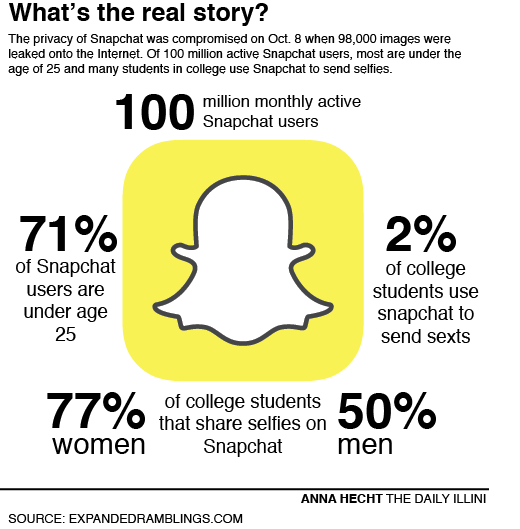Snapchat leaks approximately 98,000 pictures, videos

October 21, 2014
Kenny Withers, Internet marketing strategist, describes 2014 as “the year of hacking.”
Recently he’s been paying close attention and blogging about various leaks, such as the security breach scandals at Target, Home Depot and JP Morgan; the explicit photo leaks of high-profile celebrities including Jennifer Lawrence, and most recently, the Snapchat leak of 98,000 pictures and videos on 4chan on Oct. 8.
Withers first picked up on the Snapchat leak while browsing 4chan. He noticed numerous email addresses posted in a long thread.
“If there’s one thing you know about 4chan, they don’t usually give their personal information to the thread, so that was a trigger,” Withers said. “That’s when someone acknowledged that they had hacked into the Snapsaved server. They’d said at the time that they had hacked up to 200,000 accounts and that they would be releasing the pictures and if anyone wanted the link with the pictures, you could put your name on (the thread).”
Snapsaved is a third-party app that accesses Snapchat’s server through an application programming interface code released by Snapchat.
Get The Daily Illini in your inbox!
“The thing was that they didn’t just stop there, they went and developed a website (Snapsaved) where you could log in, provide your Snapsaved credentials and access the pictures that you had saved,” said Withers.
He added that the photos were released through a breach in the Snapsaved app’s website. Withers said a misconfiguration in the server of the Snapsaved website allowed a hacker to access the app, download pictures from it and make them public.
“The images were posted to that original website that Thursday night around 9 p.m. Pacific time. A half hour later, that site went down,” Withers said. “By the time that site went down there were already people from 4chan that had grabbed those pictures. The (original) link was just some random domain that somebody had posted on Hostgator.”
Sarah Bounab, freshman in LAS and Snapchat user, said she was skeptical of the private nature of Snapchat communication to begin with, and has kept that in mind while using the social media app.
“I’m not sending super scandalous stuff over Snapchat anyway because it does not seem that secure,” Bounab said. “I feel like anything can get leaked these days, or hacked into. I’m not going to send super important stuff. They’re just going to find a bunch of really ugly selfies.”
Bounab also explained that she does not believe much of her information is private and has come to expect that her “personal” information is available to anyone that looks hard enough.
“I feel like anyone can probably find out a ton about me just through Facebook or if they were to hack into my Snapchat stuff,” Bounab said. “In this day and age, we’re not used to a lot of privacy, just with social networking we kind of put all of our everyday stuff on it.”
As the Internet takes on a larger role in daily life, University electrical and computer engineering professor Michael Bailey said the way we collect and store information about ourselves is becoming less private.
“This notion of privacy is evolving. Just 20 years ago, sharing pictures was a very physical exercise. I had film, and I had a physical copy and there was work involved in creating that physical copy,” Bailey said. “The physical copy existed in a location that I owned and controlled, my home or my office. I was responsible for its security.”
That’s no longer the case, as Bailey explained that a lot of the steps and requirements that were once necessary to save, share and store information are now obsolete.
“What’s different now is that if I present you with a digital image, it’s essentially free for you to store it. It’s free for you to make a copy of it, and each copy is a perfect copy of my picture,” Bailey said. “As a group, as a society, we’re struggling with — what is privacy when something that belongs to me is not with me all the time? It’s not in my locked house, but in somebody else’s.”
Charlotte can be reached at [email protected].






